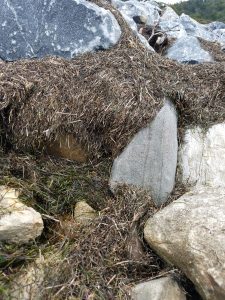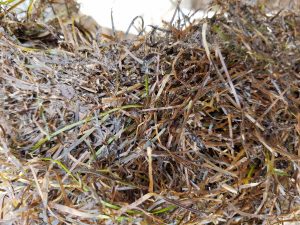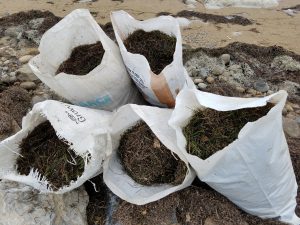Kevin was once visiting a friend with a farm by the sea and was invited to come gather sea grass for mulching. Apparentley, several coastal gardeners around the country do this. Being an ex-chemistry teacher, Kevin wanted to know more about if, and why, this method had widespread praise. Going deeper than he originally planned, he ended up starting and heading an actual funded research project in collaboration with Lincoln University, the Department of Conservation, and the Royal Society of New Zealand. He didn’t go through all the trouble of producing a peer-reviewed, academic article full of stats, but did produce an informational leaflet which was distributed to gardeners via host shops, and had it printed in an issue of Organic NZ magazine in 2013.
What he, and participating colleagues found, was quite astonishing. The most shocking thing they discovered was that the native sea grass here contains higher concentrations of Boron than any other plant they know of that grows here. It also contains unusually large amounts of magnesium, and has significant levels of calcium, manganese, and zinc, and sulfur. Additionally, it possesses valuable amounts of nitrogen and phosphorous, in concentrations similar to general-purpose mulches like woodchips and straw. Kevin’s article proves that the use of sea grass for mulching is a really good idea for many people in Golden Bay, because after doing extensive soil testing in the area has concluded that most farms are lacking in copper, sulfur, and selenium, and that there are plenty still which suffer from boron depletions, including his own garden. While there isn’t high enough concentrations of copper or selenium to really address any lacking, sea grass still contains small traces amongst the other benefits. He also concludes that sea grass is especially useful in growing boron and magnesium-loving crops such as brassicas, asparagus, garlic, beets, peas, beans, fruit an nut trees, sweet corn, and celery. I found it really inspiring that he went through all of this research, not because he was looking for money or academic recognition, but just because he wanted to assess the purpose of a previously majorly un-studied method of gardening and share his knowledge in a publicly accessible manner.
Anyways, Kevin’s garden was running low on the sea grass supply, and since he collects it from a beach he thought I’d enjoy visiting we decided to go and get some more to last him through the summer. When harvesting, we were sure not to take too much from any one spot, and instead walked around only grabbing a handful or two from many sites. We got 13 big bags full in the end, plenty for him and some to share with the neighbors too! It smelled pretty funky and had various shells and crawling, jumping insects so we shook it all out and tried to get the beach remnants off before hauling it into the car.

Uprooted and washed up sea grass lining the rocks, ready to become a helper in the garden

Handful of fresh sea grass

Bags brimming with nutrient-rich heaps
It’s best used dried, so we piled it up and covered it with a tarp to slowly become dense and lose some seawater. In a couple weeks it will be lumped underneath the apple, pear, plum, and peach trees, as well as some developing cabbage heads and sweet corn.